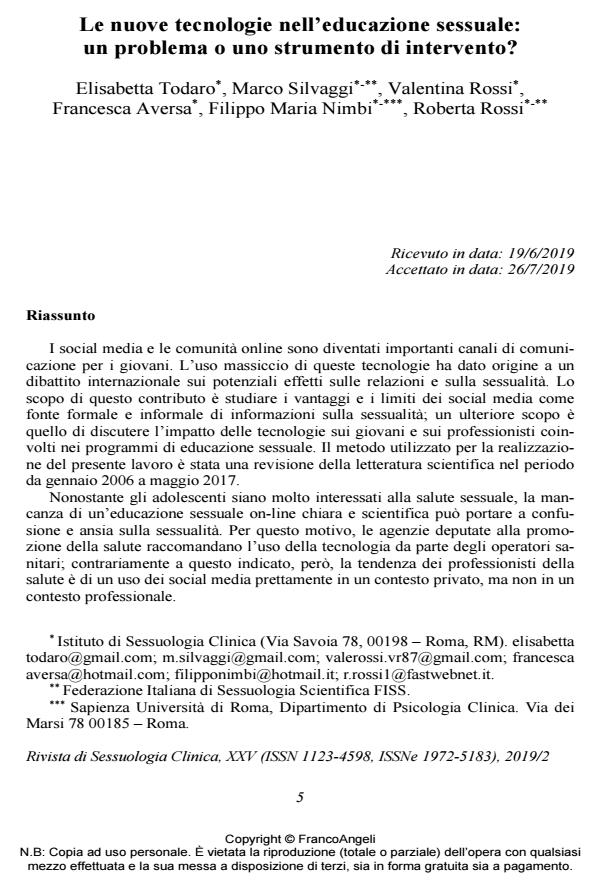New technologies in sex education: a problem or an instrument of intervention?
Journal title RIVISTA DI SESSUOLOGIA CLINICA
Author/s Elisabetta Todaro, Marco Silvaggi, Valentina Rossi, Francesca Aversa, Filippo Maria Nimbi, Roberta Rossi
Publishing Year 2019 Issue 2019/2
Language Italian Pages 16 P. 5-20 File size 193 KB
DOI 10.3280/RSC2019-002001
DOI is like a bar code for intellectual property: to have more infomation
click here
Below, you can see the article first page
If you want to buy this article in PDF format, you can do it, following the instructions to buy download credits

FrancoAngeli is member of Publishers International Linking Association, Inc (PILA), a not-for-profit association which run the CrossRef service enabling links to and from online scholarly content.
The Social Media and on-line communities have become important communi-cation channels for youth. The massive use of these technologies gave rise to an international debate on potential effects on relationships and sexuality. The aim of this paper is to study advantages and limits of Social Media as formal and in-formal source of information on sexuality; another purpose is to focus on their impact on youth and professionals involved in sexual education programs. A re-view of scientific literature from January 2006 to May 2017 was performed. De-spite adolescents are very interested about sexual health, the lack of clear and sci-entific-based on-line sex education may lead to confusion and anxiety on sexuali-ty. For this reason, health organizations recommend the use of technology by Health Care Professionals, even if data shows their attitude to use it in private, but not in a professional context. To our knowledge, most of the current studies only investigate the effect of Social Media on sexual health in terms of knowledge in-crease and attitude modification. Instead, our approach is interested in considering how technologically mediated interventions could enable information increase and promote experiences, both aspects involved in the development of sexual identity. To achieve this goal is important to take care of youth’s curiosity and to give safe and helpful tools. This requires moving beyond static views of children and young people’s risk and empowerment in the digital age towards a focus on how to sup-port, negotiate and open up the positive aspects of Social Media. In line with these purposes, it is recommended that specialists who are engaged in working with teenagers be guided by specific guideline and receive specific training to increase attitude and skills in using technologies in sexual education programs. Most of the on-line sexual education interventions are focused on adolescents’ risk behavior prevention instead of sexual well-being promotion; considering the usefulness of Social Media in sexual education, a technological tool planned by the Institute of Clinical Sexology, Rome to be used during sexual education ses-sions is presented. A critical approach development should be provided in the fu-ture to promote a safer use of Social Media in sexual education interventions, where emotions and feelings are deepened by young people together with profes-sionals. The use of technology in adolescents is not necessarily harmful for sexual health. A critical approach development should be provided to promote a safer use of such tools in the general population and a more competent use in PSs prac-tice.
Keywords: Sexual education, technology, sexual development, sexual health, so-cial media, adolescents.
- Predisposition, Vulnerability and Web in Sex Addiction Luca Rossi, Marco Chiapparino, Silvia Miceli, in Journal of Psychosexual Health /2024 pp.32
DOI: 10.1177/26318318241233069
Elisabetta Todaro, Marco Silvaggi, Valentina Rossi, Francesca Aversa, Filippo Maria Nimbi, Roberta Rossi, Le nuove tecnologie nell’educazione sessuale: un problema o uno strumento di intervento? in "RIVISTA DI SESSUOLOGIA CLINICA" 2/2019, pp 5-20, DOI: 10.3280/RSC2019-002001